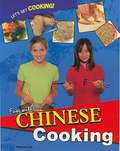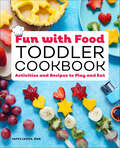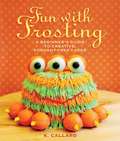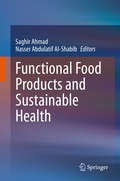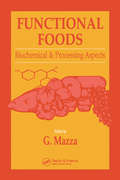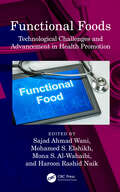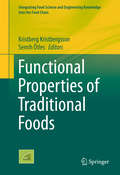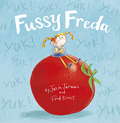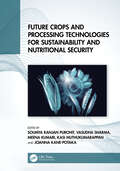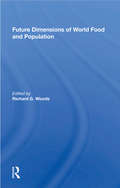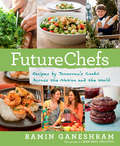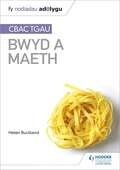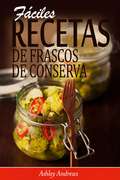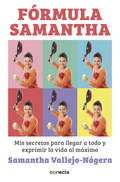- Table View
- List View
Fun with Chinese cooking (Let’s Get Cooking!)
by Frances LeeThis introduction to Chinese food also highlights the history and dishes that surround the important Chinese holiday Chinese New Year.
Fun with Food Toddler Cookbook: Activities and Recipes to Play and Eat
by Yaffi LvovaFun and easy recipes that little chefs ages 1 to 3 can make with youBond with your little one on a safe and enjoyable kitchen adventure! This toddler cookbook shows you how helping in the kitchen can teach your child to appreciate colors and textures in their favorite meals as well as hone their motor skills. Your little chef will have a blast mashing, squishing, painting, playing, and eating their way through this cookbook for kids.This toddler cookbook includes:Confidence building—Discover how cooking can help your little chef build confidence in the kitchen and pique any picky eater's appetite.Simple directions—This kids' cookbook features step-by-step recipes that are easy enough for your toddler to take the lead on with limited adult help.Chances to play—Teach your child to have fun outside the kitchen as they dig into tons of awesome food-related activities in this toddler cookbook.Help your pint-sized chef foster a lifelong love of food with the Fun with Food Toddler Cookbook.
Fun with Frosting: A Beginner's Guide to Decorating Creative, Fondant-Free Cakes
by K. CallardWant to add pizzazz to your parties?This how-to book will help you do just that! Fun with Frosting is perfect for amateur bakers looking to make and decorate delicious, creative cakes using regular bakeware (no specialty pans required!) without having to deal with finicky-and often not-so-tasty-fondant.To start, Fun with Frosting offers everything you need to know about baking, leveling, filling, and assembling cakes, cupcakes, and cakeballs. Author K. Callard also includes a rundown of must-have tools (and some clever substitutions) as well as flat-icing and piping techniques.With more than forty designs, this book will have even the youngest bakers appreciating Callard’s knowledge of her craft as they learn to make shell borders, basket weaving patterns, butter cream roses, and decorating accents using various candies, sugars, melts, and more.Step-by-step instructions for a range of cake designs, from simple 2-D treats to intricate 3-D triumphs, are certain to please any birthday kid or kid at heart.
Functional Cereals and Cereal Foods: Properties, Functionality and Applications
by Anil Kumar Siroha Sneh Punia BangarIn recent years, consumers are concentrating more on the health benefits of food in order to preserve a healthy lifestyle and therefore becoming more aware of the relationship between diet and disease. This has resulted in a gradual shift from animal-derived to plant-based meals. Functional foods have turned into one of the rapidly expanding areas of the food industry due to the increasing awareness of consumers working to prevent lethal diseases like cancer, diabetes mellitus and cardiovascular disease. Functional foods are seen as the food or food components that manifest efficiency in protecting from diseases and attaining a healthier lifestyle by administering additional benefits on human physiology and metabolic functions apart from basic nutritional requirements of the body. Cereals hold a prominent place in this new market. Cereals and cereal foods are important energy sources and many phytochemicals such as dietary fiber, resistant starch, vitamins, minerals, lignans, phytic acid and phenolic compounds that provide a variety of health benefits. Eating functional cereal foods is an easy method to increase nutrients associated with whole grains without changing eating habits. Functional Cereals and Cereal Foods: Properties, Functionality and Applications comprehensively covers the Chemistry and nutritional composition of functional cereals components, their functionality and therapeutic significance, current innovations and functional approaches in improving attributes and biofortification and quality improvement of cereal products. The different types of functional cereals and their unlimited opportunities for the production of functional foods are covered in full, including gluten-free products and all the newest cereal processing technologies. For researchers in search of a fully up-to-date look at functional cereal foods and technologies and their important place on the current market, this text provides a timely and comprehensive overview.
Functional Food Products and Sustainable Health
by Saghir Ahmad Nasser Abdulatif Al-ShabibThere is a growing global awareness of the link between good diet and health. This fascinating book reviews various functional foods or nutraceuticals and the bio-active compounds they contain in order to identify the role of bioactive compounds such as nisin, micronutrients, and hydrocolloids in the diet in overall human health. It also provides up-to-date information on functional elements like antioxidants, dietary fibres, pre & probiotics, vitamins and mineral-enriched foods in the human diet. Consisting of fifteen chapters, the book offers a systematic review of the key factors in the preparation of functional foods from selected sources, and also describes the processing, preservation and packaging of a range of functional food products. This book is a valuable resource for students and researchers working in the field of food science, food technology, and nutrition, as well as for industry experts.
Functional Foods and Biotechnology: Sources of Functional Foods and Ingredients (Food Biotechnology Series)
by Kalidas Shetty Dipayan SarkThe first of two related books that kick off the Food Biotechnology series, Functional Foods and Biotechnology: Sources of Functional Foods and Ingredients, focuses on the recent advances in the understanding of the role of cellular, metabolic, and biochemical concepts and processing that are important and relevant to improve functional foods and food ingredients targeting human health benefits. This volume explores sources of ecologically-based diversity of functional foods and food ingredients that are available to enhance diverse nutritional values and functional benefits of foods for better human health outcomes, especially focusing on emerging diet and lifestyle-linked non-communicable chronic disease (NCDs) challenges. The contributors with expertise in the field of Food Biotechnology and Functional Food Ingredients have integrated the recent advances in some common as well as novel sources of functional foods and ingredients from diverse ecological and cultural origins. Further, these chapters also highlight human health relevant bioactive profiles and associated functionalities of these health-promoting compounds, including preventative functional roles for common NCD-linked health benefits. FEATURES: Provides ecological and metabolic rational to integrate novel functional food and functional ingredient sources in wider health-focused food system innovations. Examines the value-added role of select functional foods and food ingredients to improve NCD-linked health benefits such as type-2 diabetes, cardiovascular disease, and human gut improvement Includes insights on system-based solutions to advance climate resilient and health focused food diversity based on diverse biotechnological approaches to design and integrate functional food and food ingredient sources Overall, the rationale of this book series is focused on Metabolic-Driven Rationale to Advance Biotechnological Approaches for Functional Foods, the synopsis of which is presented as the Introduction chapter, which is followed by a chapter on current understanding about regulatory guidelines for health claims of functional foods and food ingredients. Special topics on nonnutritive sweeteners, caroteneprotein from seafood waste, and Xylooligosaccharides as functional food ingredients for health-focused dietary applications are integrated in this book. Additionally, ecologically and metabolically-driven functional roles of common food sources such as corn, and barley and some novel food sources, such as ancient emmer wheat, black soybean, fava bean, herbs from Lamiaceae and functional protein ingredients and minerals from Lemnaceae are also highlighted in this volume. The overall goal is to provide insights on role of these functional food and ingredient sources for their integration in wider health-focused food systems, which will help food scientists, food industry personnel, nutritionists, crop science researchers, public health professionals, and policy makers to make appropriate decisions and to formulate strategies for improving health and well-being. A related book focuses on biological and metabolically driven mobilization of functional bioactives and ingredients and their analysis that is relevant in health and wellness.
Functional Foods and Cardiovascular Disease
by Mohammed H. Moghadasian N. A. Michael EskinCardiovascular disease remains the number one killer in North America and around the world. The staggering medical costs involved in treating patients suffering from this disease demand an alternative approach to prevent or minimize its development. In Functional Foods and Cardiovascular Disease, international researchers reveal essential up-to-dat
Functional Foods and Nutraceuticals: Bioactive Components, Formulations and Innovations
by Chukwuebuka Egbuna Genevieve Dable-TupasFunctional foods and nutraceuticals are food products that naturally offer or have been modified to offer additional health benefits beyond basic nutrition. As such products have surged in popularity in recent years, it is crucial that researchers and manufacturers understand the concepts underpinning functional foods and the opportunity they represent to improve human health, reduce healthcare costs, and support economic development worldwide.Functional Foods and Nutraceuticals: Bioactive Components, Formulations and Innovations presents a guide to functional foods from experienced professionals in key institutions around the world. The text provides background information on the health benefits, bioavailability, and safety measurements of functional foods and nutraceuticals. Subsequent chapters detail the bioactive components in functional foods responsible for these health benefits, as well as the different formulations of these products and recent innovations spurred by consumer demands. Authors emphasize product development for increased marketability, taking into account safety issues associated with functional food adulteration and solutions to be found in GMP adherence. Various food preservation methods aimed at enhancing the quality and shelf life of functional food are also highlighted. Functional Foods and Nutraceuticals: Bioactive Components, Formulations and Innovations is the first of its kind, designed to be useful to students, teachers, nutritionists, food scientists, food technologists and public health regulators alike.
Functional Foods and Nutraceuticals: Chemistry, Health Benefits and the Way Forward
by Farhan Jalees Ahmad Khalid Bashir Kulsum JanProgress in understanding the association between the health benefits of foods, prevention of diseases and immunity enhancers has led researchers to focus on functional components of foods. Considerable evidence from epidemiological, clinical and laboratory studies have shown numerous functional components in foods which may enhance immunity and help in preventing various lifestyle diseases. This book specifically documents the therapeutic roles of functional foods and their ingredients and explains their bioavailability and accessibility. Functional Foods and Nutraceuticals: Chemistry, Health Benefits and the Way Forward addresses recent advances and future prospects of health benefits in different functional foods. It also provides a thorough understanding of the bioavailability of fortificants, their mechanisms of action, extraction techniques, effects of processing, nutraceutical and nanomaterial development and legislation. The book also delivers up-to-date information regarding the techniques of fortification, their bio-accessibility and trends along with the application of nanotechnology for the development of functional foods. This text serves as a multidisciplinary source appropriate for researchers from food science and technology, biotechnology, pharmaceutical and allied sciences, Provides recent advances in extraction of phytochemicalsExplores the role of Nutraceuticals as immunity boosters and in combatting lifestyle diseases
Functional Foods: Biochemical and Processing Aspects, Volume 1
by G. MazzaThis reference provides a comprehensive treatment of the physiological effects of foods and food components capable of promoting good health and preventing or alleviating diseases. It assembles extensive information on the nature and physiological effects of biologically-active components of major plant foods. Internationally renowned specialists discuss how to manufacture and evaluate food products with health enhancing effects, using both traditional and novel processing methods. This comprehensive volume serves the information needs of food scientists and technologists, food process engineers, biochemists, nutritionists, and public health professionals.
Functional Foods: Technological Challenges and Advancement in Health Promotion
by Sajad Ahmad Wani, Mohamed S. Elshikh, Mona S. Al-Wahaibi, and Haroon Rashid NaikIt is reported Functional foods are highly nutritious and associated with a number of powerful health benefits. They may protect against disease, prevent nutrient deficiencies, and promote proper growth and development. Functional Foods: Technological Challenges and Advancement in Health Promotion presents information related to bioactive compounds present in the functional foods, derived from fruits and vegetables, cereals and pulses, dairy and meat, herbs and spices and other foods. It describes novel techniques and methodologies used in the extraction, isolation, encapsulation, identification and characterization of bioactive compounds. Key Features: Covers the most recent research related to the bioactive compounds present in the functional foods Presents the latest information on extraction, isolation, encapsulation, identification and characterization Discusses formulation challenges with an emphasis on stability and safety evaluations of functional foods Finally, it includes substantial and scientific research and innovation for new product development with health benefits. This book will serve as a valuable resource for researchers, academicians, and students interested in many aspects of functional foods.
Functional Properties of Traditional Foods
by Kristberg Kristbergsson Semih ÖtlesThis third book in the Trilogy of Traditional Foods, part of the ISEKI Food Series, covers the beneficial properties of functional foods from across the world. The volume is divided into four sections that address different key topics in the area of study. Part I provides a general overview of the material, with chapters on functional aspects of antioxidants and probiotics in traditional food. This section also includes chapters on the potential health benefits of Thai, Slovak and Turkish traditional foods. Part II contains eight chapters on cereal-based foods, including chapters on Carob flour, products from Mexican Chia, and the ancient grain Cañahua. Part III is devoted to plant based foods and includes chapters on dates from Israel, medical properties of cactus products from Mexico, beneficial properties of Mastic gum from the Greek island Chios, and the properties of Argan oil from Morocco. Part IV focuses on Honey and Beverages, with chapters on functional and nutritional properties of honey and the properties of Camellia tea, as well as the Spanish drink Horchata De Chufa. The purpose of the book is to describe and sometimes evaluate properties of foods that native consumers have believed to be beneficial. All chapters are written by practicing Food Scientists or Engineers but are written with the interested general public in mind. The book should cater to the practicing food professional as well as all who are interested in beneficial properties of traditional foods.
Fundamentals of Drug and Non-Drug Interactions: Physiopathological Perspectives and Clinical Approaches
by James O. FajemiroyeThis book covers nutrients, active principles from phytotherapy/herbal products, and drug classes while identifying potential interactions. Didactic approaches to drug and non-drug interactions and cutting-edge reports are included in each chapter that promotes safer drug prescription and use. The physiopathological overview in this book provides background for chemistry, pharmacology, and mechanistic bases of drug and non-drug interaction as well as clinical cases and predictive screenings. This book is intended for undergraduate students studying medicine, nursing, nutrition, biomedicine, and pharmacy.
Funktionelle Störungen der Nahrungsaufnahme bei Kindern und Jugendlichen: Interdisziplinärer Praxisleitfaden
by Margarete Bolten Corinne Légeret Simone OdenheimerDas Buch behandelt Beeinträchtigungen bei der Nahrungsaufnahme im Kindes- und Jugendalter, die nicht allein durch organische Ursachen erklärt werden können: frühkindliche Fütter- und Essstörungen, Sondendependenz, funktionelles Erbrechen, Ruminationsstörungen und funktionelle Dysphagien. Im Sinne einer ganzheitlichen Betrachtung stellt dieser Leitfaden die Entstehungsbedingungen und das interdisziplinäre Vorgehen bei der Diagnostik und Behandlung funktioneller Störungen der Nahrungsaufnahme bei Kindern und Jugendlichen dar. Das Buch richtet sich an Fachpersonen aus der Kinder- und Jugendmedizin, aus der Psychotherapie, Logopädie, Ergotherapie und Physiotherapie.
Fuss-Free Vegan: 101 Everyday Comfort Food Favorites, Veganized
by Sam TurnbullBeing vegan doesn’t have to mean living off kale and quinoa, or spending your money on fancy and expensive ingredients. And it definitely doesn’t have to mean feeling limited for choices of what to eat! What if “vegan food” could mean cheesy nachos and pizza, hearty burritos, gooey spinach and artichoke dip, decadent chocolate cake or even crème brûlée? Well, it can. In Fuss-Free Vegan, Sam Turnbull shows you that “vegan” does not equal unappetizing dishes, complicated steps, ingredients you have never heard of, or even food that tastes healthy. Instead, she gives you drool-worthy yet utterly fuss-free recipes that will bring everyone together at the table, vegans and non-vegans alike, in a chorus of rave reviews. This is the cookbook Sam wishes she had when she went vegan: one that recreates and veganizes the dishes she loved most in her pre-vegan days, like fluffy pancakes and crispy bacon, cheesy jalapeño poppers and pizza pockets, creamy Caesar salad and macaroni and cheese, rich chocolate brownies and holiday-worthy pumpkin pie, to name just a few. (And there’s no hummus recipe in sight.) Say goodbye to searching endlessly around for that one special ingredient that you can't even pronounce, or cooking dishes that don’t deliver on their promise of yumminess; instead, say hello to ingredients you can pick up at your local grocery store, step-by-step techniques, and Sam’s enthusiastic voice cheering you on throughout this fun, approachable cookbook. With 101 tried-and-tested, one-of-a-kind vegan recipes for every meal, from breakfasts to lunches to dinners, and even snacks, desserts, appetizers and vegan staples, as well as handy menu plans and tips to amp up the recipes and your vegan life, Sam Turnbull and Fuss-Free Vegan are your ultimate guides in the new vegan kitchen.
Fussy Freda
by Julia JarmanA deliciously funny rhyming tale. Perfect for fussy eaters and their despairing parents!Dinnertime isn't easy in Freda's house.Mum cooks beans. YUK!Grandma cooks fish and chips. YUK!Dad cooks crispy duck. YUK! YUK! YUK!There just isn't any pleasing Fussy Freda. But her cat is not so fussy, and this causes a culinary catastrophe!This cautionary tale will have toddlers calling out for more, and more, and MORE!
Future Crops and Processing Technologies for Sustainability and Nutritional Security
by Vasudha Sharma Soumya Ranjan Purohit Meena Kumari Kasi Muthukumarappan Joanna Kane-PotakaOur current food system faces challenges across the board – from ensuring food security and reducing environmental impact to managing costs and minimizing waste. Fortunately, cutting-edge food processing technologies play a critical role in paving the way for a more sustainable future. Taking a two-track approach, Future Crops and Processing Technologies for Sustainability and Nutritional Security presents sustainable technologies and emerging crops that are capable of ensuring nutritional security. There are various crops that are nutritious but under-utilized. Crops covered in the book are those that are climate resilient and exhibit less use of water and zero discharge to environment, such as millets and legumes like chickpea, groundnuts, and pigeon pea.KEY FEATURES: Provides a comprehensive literature review on the opportunities and challenges in achieving sustainability and nutritional security Presents compatible, relevant crops to address both sustainability and nutritional security Discusses the emerging technologies/crops/food products to justify sustainability and potential to ensure nutritional security This book also provides information on all aspects related to the processing and use of sustainable technologies and crops. The use of technologies like 3D printing, novel drying method, high pressure processing, high-voltage treatments, and the proper combination of conventional methods are addressed.
Future Dimensions Of World Food And Population
by Richard G. WoodsIs it possible to feed those who now are hungry in the world in addition to the billions of people who will be born by the end of the century? Or are we headed for an inevitable Malthusian catastrophe because the task is impossible? What can developing countries do to increase agricultural self-reliance? What population dynamics accompany the transition from high birth and death rates in developing countries to low birth and death rates? What research can aid the struggle to provide food to the world's masses? These and other questions are explored by an array of experts who participated in the Congressional Roundtable on World Food and Population during 1979-80. They offer this collection of papers in the spirit of optimism about the future and about the U.S. role in international development.
FutureChefs: Recipes by Tomorrow#s Cooks Across the Nation and the World
by Ramin Ganeshram Jean Paul VellottiA 2015 IACP Cookbook Awards Winner: Children, Youth and FamilyA curated collection of 150 recipes drawn from the experience and kitchens of young cooks all over America, FutureChefs brings real, cooking-obsessed tweens and teens to the page as relatable characters who span a diverse social and cultural experience. Here, in rich, inspiring detail, is the ethnoculinary America of the future. Veteran journalist and trained chef Ramin Ganeshram has crafted profiles of serious young cooks who run the gamut of experience, ethnic, and socioeconomic backgrounds to create an inspiring prism through which readers might see what's ahead in America's food culture. Whether they've taken to it because of necessity, inspiration, or sheer passion, these are kids, teens, and tweens who are very serious about food. Featuring recipes from young celebrity chefs Logan Guleff, winner FOX's MasterChef Jr, and Kid Chef Eliana de Las Casas, Daniel Hamilton, Alessandra Ciuffo, and Jack Witherspoon from Food Network's Rachael versus Guy, as well as the White House's Healthy Lunchtime Challenge winners Sydney Michael Brown and Haile Thomas.This is a generation more interested in hands-on cooking than ever, but they're lacking material that treats them as a serious part of cooking culture; FutureChefs is the perfect vehicle.
Futureproof: Build Resilience, Feel Younger, Live Longer
by Davinia TaylorTwo-time number one Sunday Times bestseller and biohacking pioneer Davinia Taylor turns her attention to longevity in her brand new book Futureproof.In this book, Davinia shares her own experience of lowering her biological age and feeling younger and healthier than she did ten years ago. Futureproof is broken down into five sections covering everything you need to know to do the same, with simple and sustainable lifestyle changes. It will show you how to:TACKLE INFLAMMATIONBUILD MUSCLEEAT MORE PROTEINGET MOBILEMANAGE STRESSThis empowering and practical book will help you to feel amazing now, and keep you healthy for a long and happy life. You deserve to feel resilient and full of energy in every decade and Futureproof will empower you with all the tools you need to thrive.
Futureproof: Build Resilience, Feel Younger, Live Longer
by Davinia TaylorTwo-time number one Sunday Times bestseller and biohacking pioneer Davinia Taylor turns her attention to longevity in her brand new book Futureproof.In this book, Davinia shares her own experience of lowering her biological age and feeling younger and healthier than she did ten years ago. Futureproof is broken down into five sections covering everything you need to know to do the same, with simple and sustainable lifestyle changes. It will show you how to:TACKLE INFLAMMATIONBUILD MUSCLEEAT MORE PROTEINGET MOBILEMANAGE STRESSThis empowering and practical book will help you to feel amazing now, and keep you healthy for a long and happy life. You deserve to feel resilient and full of energy in every decade and Futureproof will empower you with all the tools you need to thrive.
Fy Nodiadau Adolygu (My Revision Notes (My Revision Notes (My Revision Notes (My Revision Notes: WJEC GCSE Food and Nutrition Welsh-language edition): Cbac Tga Bwyd A Maeth(mrn:gcse Food And Nut)epb
by Helen BucklandExam Board: WJECLanguage: WelshLevel: GCSESubject: Food PreparationFirst Teaching: September 2016First Exam: Summer 2018Unlock your full potential with this revision guide that will guide you through the content and skills you need to succeed in the WJEC GCSE Food Preparation and Nutrition exam.- Plan your own revision and focus on the areas you need to revise with key fact summaries and revision activities for every topic.- Use the exam tips to clarify key points and avoid making typical mistakes.- Test yourself with end-of-topic questions and answers and tick off each topic as you complete it.- Get ready for the exam with tips on approaching the paper, and sample exam questions with model answers and commentary.
Fy Nodiadau Adolygu: CBAC TGA Bwyd a Maeth (My Revision Notes: WJEC GCSE Food and Nutrition Welsh-language edition)
by Helen BucklandExam Board: WJECLanguage: WelshLevel: GCSESubject: Food PreparationFirst Teaching: September 2016First Exam: Summer 2018Unlock your full potential with this revision guide that will guide you through the content and skills you need to succeed in the WJEC GCSE Food Preparation and Nutrition exam.- Plan your own revision and focus on the areas you need to revise with key fact summaries and revision activities for every topic.- Use the exam tips to clarify key points and avoid making typical mistakes.- Test yourself with end-of-topic questions and answers and tick off each topic as you complete it.- Get ready for the exam with tips on approaching the paper, and sample exam questions with model answers and commentary.
Fáciles Recetas de Frascos de Conserva
by Ashley Andrews David Arieta Galván50 Deliciosas Recetas Esta colección de 50 recetas de frascos de conserva deliciosas y fáciles de preparar pueden ser utilizadas para hacer regalos de navidad caseros, para recrear con invitados o incluso para preparar almuerzos para la semana. En este libro encontrarás comidas enteras en un frasco, desde desayuno hasta almuerzo y cena. También encontrarás una variedad de sabrosas sorpresas y exquisitos postres como pays, pasteles, helados, batidos y más. Incluso encontrarás sopas y ensaladas para cuando quieras hacer elecciones saludables. Úsalas con regalos... o para entretener a tus invitados. Estas comidas son económicas y deliciosas. Simplemente compra un set de frascos de conserva y utilízalos una y otra vez para ti y tu familia. Si estas utilizando este libro para hacer ese tipo de regalos especiales, simplemente adorna con un listón y ata una nota hecha a mano sobre una tarjeta de regalo para ese toque personal. La gente ama recibir algo que luzca genial y que puedan disfrutar consintiéndose. Obsequios para toda ocasión. Escoge tus recetas favoritas y utilízalas para entretenerte. Antes de que los invitados lleguen decora la mesa con una selección de postres en mini frascos. Cada uno tendrá su propio regalo personal. Puedes incluso traerlos contigo para tu próxima fiesta o reunión ya que son súper fáciles de llevar. Aquí solo una probadita de lo que encontrarás... Ensalada Caprese en Frasco de Conserva Desayuno de Postre helado en frasco Frasco de Conserva de Ensalada Cobb Frasco de Conserva de Ensalada Taco Frasco de Conserva de Salsa de Habichuelas en Capas Frasco de Conserva de Ensalada de Pollo Búfalo Panqueque de Fresa en Frasco Tocino y Huevo en Frasco Frasco de Conserva de pollo Guisado Sopa de Tortilla en Frasco Pastel de Queso No Horneado en Frasco Frasco de Conserva de S'mor
Fórmula Samantha: Mis secretos para llegar a todo y exprimir la vida al máximo
by Samantha Vallejo-NágeraLa jurado de MasterChef, empresaria y madre Samantha Vallejo-Nágera nos desvela sus secretos para llegar a todo y exprimir la vida al máximo. «No puedes esperar a que la felicidad venga de fuera, o al menos no siempre. Hay que perseguirla, organizar tu vida para alcanzarla. Por eso la lleno de luz, de color, de motivos graciosos, de lugares con encanto, de gente vital. Porque quiero vivir la vida con entusiasmo, exprimiéndola a tope. Solo así merece ser vivida.»Samantha Vallejo-NágeraSamantha Vallejo-Nágera se define a sí misma como «empresaria y madre total». Empezó a los 25 años creando un servicio de catering que hoy es uno de los más prestigiosos de España y donde trabajan más de 40 personas. Es madre de familia numerosa, con cuatro hijos todavía pequeños. Y por si todo esto fuera poco, participa como jurado en el famoso programa de televisión MasterChef y es tremendamente activa en las redes sociales en las que ha conseguido infinidad de seguidores. Samantha reconoce que no le queda ni un minuto libre#, pero que su vida es muy divertida y apasionante. En Fórmula Samantha ella misma nos cuenta los secretos que le permiten llevar una vida plena con una actividad frenética: la importancia de la organización y de la administración del tiempo, la necesidad de contar con un buen equipo y de saber confiar y delegar en ellos y la salud y el ejercicio como ingredientes imprescindibles para el equilibrio personal. Porque, como bien sabe Samantha, compaginar una vida profesional trepidante con la felicidad y el equilibrio personal es posible.
